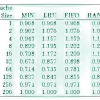Free Online Productivity Tools
i2Speak
i2Symbol
i2OCR
iTex2Img
iWeb2Print
iWeb2Shot
i2Type
iPdf2Split
iPdf2Merge
i2Bopomofo
i2Arabic
i2Style
i2Image
i2PDF
iLatex2Rtf
Sci2ools
100
click to vote
Publication
Characteristics of Destination Address Locality in Computer Networks: A Comparison of Caching Schemes
The size of computer networks, along with their bandwidths, is growing exponentially. To support these large, high-speed networks, it is neccessary to be able to forward packets in a few microseconds. One part of the forwarding operation consists of searching through a large address databse. This problem is encountered in the design of bridges, routers, gateways and name servers.
Caching can reduce the lookup time if there is a locality in the address reference pattern. Using a destination reference trace measured on an extended local are a network, we attempt to see if the destination refernces do have a significant locality.
We compared the performance of MIN, LRU, FIFO, and random cache replacement algorithms. We found that the interactive (terminal) traffic in our sample had quite different locality behavior than that of the noninteractive traffic. The interactive traffic did not follow the LRU stack model while the noninteractivetraffic did. Examples are shown of the environ...
| Added | 31 Jan 2009 |
| Updated | 01 Feb 2009 |
| Type | Journal |
| Year | 1990 |
| Where | Journal of Computer Networks and ISDN |
| Authors | R. Jain |
Comments (0)




